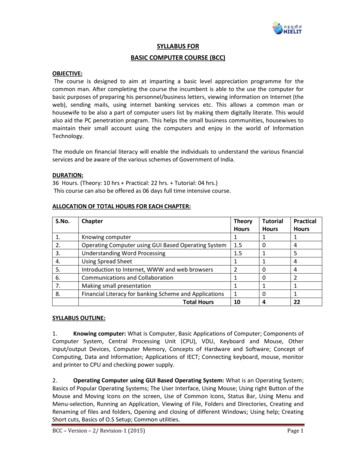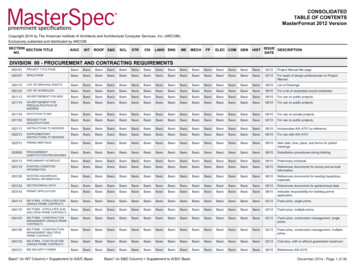
Transcription
ב"ה SyllabusBasic Judaism CourseCopr. 2009 Rabbi Noah GradofskyBasic Judaism CourseBy: Rabbi Noah GradofskyGreetings and Overview . 3Class Topics . 3Reccomended Resources . 4Live It, Learn It . 6On Gender Neutrality. 7Adult Bar/Bat Mitzvah. 8Contact Information . 8What is Prayer? . 9Who Is Supposed To Pray?. 10Studying Judaism With Honesty and Integrity . 10Why Are Women and Men Treated Differently in the Synagogue? . 11How often do we pray and when?. 12The Real Jewish Standard Time . 12All Prayers May Be Done in Any Language . 13Why Do Men and Women Sit Separately in Some Synagogues? . 13We Pray in Plural . 13What is a Minyan? . 14What Are They Mumbling? . 14Kaddish . 14The Half Kaddish. 15The Mourner’s Kaddish . 16The Full Kaddish (Kaddish Titkabal) . 17The Rabbi’s Kaddish. 18Rules and Practices Regarding Kaddish . 18The Amidah (AKA “Shemoneh Esreh”). 19The Beginning and End of Every Amidah. 19The Middle Blessings of the Weekday Amidah . 20The Middle Blessing of the Sabbath and Holiday Amidah . 21Amidah Blessings Chart . 22Additions to the Amidah For Specific Days . 22The Repetition of the Amidah. 22The Power of Amen . 23Additions to the Repetition of the Amidah (Kedushah, Rabbi’s Modim, Priestly Blessing)23Rules and Practices of Reciting the Amidah. 24The Shema . 26Blessings Which Accompany the Shema . 27Rules and Customs Regarding the Reciting of Shema and Her Blessings . 28Interruption Between the Shema’s Blessings and the Amidah. 29Shacharit: The Morning Service . 29Prayers Generally Recited Before Synagogue Services. . 29Modeh Ani and Elohay Neshamah: Thanking God for Waking Up. 29The Blessing on the Study of Torah . 30Blessings on Putting On the Talit and Tefillin. 301
ב"ה SyllabusBasic Judaism CourseCopr. 2009 Rabbi Noah GradofskyThanking God For Our Bodily Functions. 30Washing of the Hands. 30Mah Tovu. 31Birchot Hashachar – Morning Blessings . 31What is a Beracha Levatalah (Vain Blessing)?. 32Morning Prayers That Are Often Skipped . 32Akeida (The binding of Isaac) . 33Early Shema . 33Korbanot (Sacrifices) . 33Brayta D'rabi Yishmael - Teaching of Rabbi Yishmael . 33Psalm 30. 33Pesukei D'Zimrah - Verses of song. 33The Shema and Her Blessings . 34The Amidah is recited. 34On Most Weekdays, Tachanun is Recited. . 34Hallel is recited on holidays and Rosh Chodesh. 35The Torah is read on Mondays, Thursdays, Holidays, and Rosh Chodesh. . 35The Procedure for an Aliyah. 36What is a Mi Sheberach? . 37The Conclusion of Weekday Morning Services . 37Alenu. 38The Continuation of the Sabbath/Holiday Morning Service . 38Mincha: The Afternoon Service. 39Ma’ariv: The Evening Service . 39Friday Night Services (Kabbalath Shabbat). 40Goals of This Section. 41Sources. 41The Bible. 41TaNa”Ch - The three Major subdivisions of the Bible . 42Torah – The Five Books of Moses. 441) Bereshit - Genesis. 442) Shemot - Exodus. 453) Vayikra - Leviticus . 464) Bamidbar - Numbers . 465) Devarim - Deuteronomy. 48Nevi’im – The Prophets . 48The Former Prophets. 491) Yehoshua - Joshua . 492) Shofetim - Judges . 493-4) I-II Samuel. 505-6) I – II Kings . 59The Latter Prophets. 721) Isaiah. 72Isaiah 40-66. 782) Jeremiah. 863) Ezekiel . 1042
ב"ה SyllabusBasic Judaism CourseCopr. 2009 Rabbi Noah Gradofsky4) The “Minor Prophets” AKA “The 12.” . 128a) Hosea . 128b) Joel. 133c) Amos. 136d) Ovadiah. 141e) Jonah . 142f) Micah. 146g) Nahum . 149h) Habakuk. 151i) Zephaniah . 153j) Haggai. 155k) Zechariah . 157l) Malachi . 164Ketuvim – The Writings . 1661) Psalms (Tehilim). 1662) Proverbs (Mishle) . 1703) Job. 1755) Ruth . 1766) Lamentations (Aycha) . 1808) Esther . 184SYLLABUSGREETINGS AND OVERVIEWWelcome to the Basic Judaism Course. I am delighted that you have chosen to take this veryimportant step towards your personal development as a Jewish person. The goal of this course isto familiarize you with many of the basic elements of Jewish practice, culture, and history.I have designed this course to hit many of the important facets of Jewish life. Generally, I hopethat each topic will be covered in one or two sessions. However, it is more important to me thateach of you get a good understanding of the given topic, and that we satisfy any curiosities thatcome up. Therefore, we will welcome your comments and questions, even if they seem to go abit far afield. In fact, you will even find that the handouts for each class address many tangents.Hopefully, these tangents will give you a more broad-based understanding of Judaism. If youfeel that the class is moving too slowly, or getting too sidetracked, please address those concernsto me, and we will try to shift the focus a bit.This course will probably be a little more than basic. This way, even if you know a thing or twoabout Judaism, I think you will get a lot out of this course.CLASS TOPICSI plan to cover the following subjects during this course (in approximately this order): The Siddur (prayer book). This will be our first topic.3
ב"ה SyllabusBasic Judaism CourseCopr. 2009 Rabbi Noah Gradofsky Other commandments, including:o Tefillino Mezuzao Tzitsito Blessings on foodo Other blessingsThe Sabbath and Jewish holidaysKashruthJewish Literature from the Torah to TodayLife cycle eventsSynagogue skills and behaviorJewish denominationsJewish historyThe National Jewish Outreach Program’s Level II Hebrew Reading CourseThroughout this course, we should consider the following questions: What are our beliefs about God and how God desires for us to behave? What is Halacha (Jewish law), and how do we determine Halacha?The handout material for this course will have many footnotes and discussion sections. Theseare fairly important, as they capture many of the important facets of Jewish law and religion.Text in shaded sections contains information which I found interesting to share, but are far moretangential.RECCOMENDED RESOURCESAlong with this course, I recommend the following resources for more information. Throughoutthe course, I will refer to pages in these resources that discuss our topics, using the abbreviationsindicated. Most of these resources will be available at a Jewish bookstore, or likely also at aregular bookstore. They are also readily available online. Bargain hunters may care to compareprices by going to www.addall.com or www.campusi.com. If there is significant interest, I canlook into putting together a group order. To Be A Jew (TBAJ) by Rabbi Hayim Halevy Donin. A great book whichsummarizes many of the important facets of Judaism in a very readable manner.ISBN: 0465086241 (cloth), 0465086322 (paperback).To Pray as a Jew (TPAAJ) by Rabbi Hayim Halevy Donin. A great guide to allprayer services – weekdays, Sabbath, and holidays. ISBN: 0465086284 (cloth)0465086330 (paperback).A Guide to Jewish Religious Practice (Klein) by Rabbi Isaac Klein. This is afairly complete discussion of al facets of Jewish laws and observances. RabbiKlein was one of the great halachists of the Conservative movement of the pastgeneration. His work does include many of the decisions of the Conservativemovement’s Committee on Jewish laws and Standards, with which I generallydisagree. However, as an accessible guide to Jewish law, this work is second tonone. ISBN: 0873340043.4
ב"ה SyllabusBasic Judaism CourseCopr. 2009 Rabbi Noah Gradofsky The Art Scroll Siddur (AS): This prayer book is written from a very Orthodoxperspective. However, it is by far the most user friendly siddur out there. Itincludes all the stage direction – when to stand, when to sit, when to bow, whatpage to turn to next, etc. It also has lots of ommentary and explanation (althoughtheir comments must often be taken with a grain of salt). I recommend the "RCAEdition," which includes prayers for the US government and for the State ofIsrael, http://www.artscroll.com/Books/srca.html, ISBN ectionhttp://www.templeisraeloflb.org/Extras.html has many great resources. I find theJewish Virtual Library http://www.jewishvirtuallibrary.com to be particularlyexcellent. They have a thorough glossary. Also, click on their “The Library” andthen “Religion” and then “Judiasm” for lots of great pieces about Judaism.I will also refer to Jewish Liturgy: A Coprehensive History by Ismar Elbogen (Trans. RaymondP. Scheindlin), ISBN 0827604459. Elbogen’s books is one of my favorites, though it is highlyacademic and by no means a “beginners” book. For the Jewish literature section, the materialwill be based on Encyclopedia Judaica CD-ROM edition article “Jewish Literature.” And “TheEncyclopedia of the Jewish Religion,” ed. Werblowsky & Wigoder, New York: Holt, Rinehartand Winston, Inc., 1966, which I also used in preparing this text.5
ב"ה SyllabusBasic Judaism CourseCopr. 2009 Rabbi Noah GradofskyLIVE IT, LEARN ITAs with all subjects of study, discussion and learning can only go so far. One cannot trulyunderstand Judaism without experiencing it. Of course, I would love for everyone to be fullyobservant of Jewish law. However, we know that we are not all (yet) in that situation. However,I think it is very important that you experience the Judaism that we are discussing. You may findthat what you once thought would be difficult turns out to be meaningful and relaxing. In orderto get a full flavor for what we are studying, I would encourage you to try as many of thefollowing as possible: Attend all types of synagogue services. Of course, I would love for people tobecome regular attendees of minyans. But at the least, try to “collect the wholeset” of these services. You may be surprised to learn that not all synagogueservices start at 9:00AM and go to around noon. Here are the different types ofservices you could attend:o Weekday morning services without Torah Reading: Sunday & Holidays:8:30, Tuesday, Wednesday, Friday 7:15. Approximate length: 30 minutes.o Weekday morning services with Torah Reading: Monday, Thursday: 7:00.Approximate length: 45 minutes.o Weekday evening services: Based on sundown.o Friday evening services (“Kabbalat Shabbat”): Based on sundown.Currently 4:15 PM. Approximate length: 1 hour, with lots of livelysinging.o Saturday morning services: 9:00AM Approximate length: 2 ¾ hours.o Saturday afternoon services: Based on sundown. Approximate length: 1¼ hours, including a light meal.o Holiday services: including: Sukkot Simchhat Torah Purim Passover Shavuot Tisha B’avPray at home: There are many benefits to praying in synagogue (more on thatduring our “Guided Tour to the Siddur”). However, at its basic level, theobligation to pray can be fulfilled by praying anywhere (you haven’t lived untilyou pray the afternoon service at a highway rest stop). After we have completedthe “Guided Tour,” and equipped with a helpful siddur such as Art Scroll, youshould be able to do the synagogue service. I will be happy to guide you along.Remember that you can always pray in English or in Hebrew.Say shema in the morning and evening. This is a very important mitzvah thatcan be done in a matter of minutes.Observe a Sabbath: Many people think that Sabbath observance would beburdensome. You’ll find that in fact it is relaxing and rejuvenating. Pick aSabbath that you will try to observe completely (we’ll be learning what thisinvolves). It is important that you plan your Sabbath time, including synagogue6
ב"ה SyllabusBasic Judaism CourseCopr. 2009 Rabbi Noah Gradofsky attendance and special meals (if you can get to my apartment, I’ll be happy toinvite you for a meal).Shabbat home ritual: Light Shabbat candles before sundown (you can look atThis Week @ Temple Israel or our website for the time). Make Kiddush overwine/grape juice, and hamotsee on challah (we’ll learn all about these rituals).Enjoy a great meal. Try to do the same thing for Saturday lunch (kiddush is a bitdifferent, and there are no candles). Then, on Saturday night 45 minutes or moreafter sundown, do Havdallah. Try to make these rituals a regular occurrence inyour life.Try keeping a kosher home for two weeks: We’ll learn about keeping kosher.Especially living in New York, it’s not as tough as you think. You don’t need tokasher your home (more on what that means later in the course) for this trialperiod. Just buy only kosher foods, and don’t cook/serve any combinations ofmeat and milk. Wait at least 3 hours (some people do 1 hour) after eating meatbefore you eat anything dairy. Try out some of the great kosher restaurants ourarea has to offer (I can make recommendations).ON GENDER NEUTRALITYModern society has taught us, I believe correctly, to be highly sensitized to gender biases that areinherent in the way we speak and act. I shall do my best to be sensitive to these issues.However, when I translate text, I am often forced to use gender specific terms so as to bestcapture the linguistic style of the writing. This is especially true of Hebrew, which makes heavyuse of pronouns or assumed nouns. One could translate using a proper noun, however, this senseof propriety comes at a cost of accuracy, a price I am often unwilling to pay. This is especiallyproblematic as it often forces me to translate references to God using a masculine pronoun,which is both potentially offensive, and worse yet a gross injustice to a religion that staunchlyrejects associating human features to God. Heaven forefend that we should think of God aseither male or female. However, when Kaddish says May His great name be sanctified andmagnified. I feel that a translation of May God’s great name . . . would misrepresent the text.Therefore, any gender specific translations during this class should be understood as a necessaryevil of translating from one language to another.7
ב"ה SyllabusBasic Judaism CourseCopr. 2009 Rabbi Noah GradofskyADULT BAR/BAT MITZVAHParticipants in this course are welcome to be a part of this class simply for the learning, or inanticipation of an adult Bar or Bat Mitzvah ceremony. If you are interested in participating in anadult Bar/Bat Mitzvah ceremony, either on your own or along with others, please speak to me.CONTACT INFORMATIONIf you would like to speak to me outside of class time, feel free to call or stop by at my office. Ido not keep official office hours, so it makes sense to call to make sure I am here. Thesynagogue number is (516) 432-1410. You can reach me on my cell phone for emergencies, orfor any time-sensitive matter: (917) 686-0552.I can be e-mailed atRabbiNoahG@templeisraeloflb.org or contacted by AIM at RabbiNoahG.8
ב"ה A Guided Tour to the SiddurBasic Judaism CourseCopr. 2007 Rabbi Noah GradofskyA GUIDED TOUR TO THE SIDDURBy: Rabbi Noah GradofskyWHAT IS PRAYER?Maimonides1, in his section on Laws of Prayer in the Mishneh Torah, introduces the idea ofprayer as follows: מפי השמועה למדו , מצות עשה להתפלל בכל יום שנאמר ועבדתם את ה' אלהיכם שעבודה זו היא תפלה שנאמר ולעבדו בכל לבבכם אמרו חכמים אי זו היא עבודה . שבלב זו תפלה It is a positive mitzvah2 to pray each- day, as it is said (Exodus 23:25) "And youshall worship the Lord your God." From tradition the sages learned that thisservice is prayer, as it is said: (Deut 11:13, part of the second paragraph ofShema) "and to serve God with all your heart." The sages said: what is servicewith the heart? Prayer.Thus, at its core, prayer is service of God through our hearts (i.e. emotions).Rabbinic literature (see e.g. Babylonian Talmud3 Berachot 26b) also indicates that prayer ismeant as a reflection of the animal sacrifice that were made in the ( בית המקדש Beth Mikdash), theHoly Temple in Jerusalem.It is also worth noting that the Hebrew word for prayer, ( תפילה tefillah) means "self judgment."Thus, when we pray, we talk not only to God, but to ourselves. As much as we givethanksgiving to God, and ask God for help in the future, we also use prayer for introspection reminding ourselves of our personal responsibilities.1Rabbi Moses Maimonides (AKA Moses ben (son of) Maimon, or by his acronym RaMBa"m)(1135-1204). Rabbi and philosopher. Authored a commentary on the Mishnah (a compilation ofrabbinic teachings from the late 2nd century), a code of Jewish law known as the Mishneh Torah,and famed philosophical work, "The Guide to the Perplexed."2Mitzvah: Literally "commandment." This is used to refer to any action that is required byJewish law. However, it is often used more generally as meaning "a good deed."3Babylonian Talmud: Document of discussions of rabbis concerning Jewish law, philosophy,legend, etc. compiled somewhere in about the 5th or 6th century in Babylonia (modern day Iraq).Often referred to as "The Talmud," as opposed to a similar compilation, the "Jerusalem Talmud"which was likely completed around the beginning of the 5th century. The Talmuds both functionas a commentary on the Mishnah (defined at footnote 4).9
ב"ה A Guided Tour to the SiddurBasic Judaism CourseCopr. 2007 Rabbi Noah GradofskyWHO IS SUPPOSED TO PRAY?The Mishnah4 (Berachot 3:3) says that women (as well as men) are obligated to pray. However,there is significant debate as to how far this obligation goes. According to some, women aremerely obligated to pray once a day, and do not need to follow any set text such as the Amidah(defined below). According to others, women are obligated in exactly the same way as men.Though the evidence is not at all clear, at the moment I lean towards the school of thought thatwomen are of equal obligation to men.5STUDYING JUDAISM WITH HONESTY AND INTEGRITYThis is the first time during this course that we are encountering the idea of different rules thatapply to men and women in Judaism. This is one of several areas of Jewish law which, quiteunderstandably, upsets people. Philosophically, some view such laws as divine fiat. Others viewsuch laws as the result of the sociology in which Judaism was born, but view such laws asnonetheless binding until today because Jewish law is, at least in certain respects, not subject toamendment. There are those who would choose to ignore or hide these difficulties. Still otherswill simply dismiss and eliminate these difficulties by changing Jewish practice. We will doneither. We will do our best to explain Jewish life fully and honestly, even if we might findcertain facets to be difficult. Let us remember that learning about Judaism is a mitzvah (acommandment), and therefore should be done with intelligence and honesty. As my teacherRabbi Halivni puts it, we must combine אמונה צרופה ויושר דעת - genuine faith withintellectual honesty. One cannot survive without the other. Without intellectual honesty, ourfaith is not in God, but in ourselves. Religion becomes not a matter of faith, but a matter of ourown desires. This is true whether we impose upon Judaism an “orthodox” belief that is4Mishnah: A compilation of rabbinic statements about Jewish law compiled in the late 2ndcentury by Rabbi Judah the Prince. Theories vary as to the purpose of the work - it is either alaw code, a school book, or a bit of both. Together with the Gemara, which is a commentary onthe Mishnah (one produced in Babylonia, one in Israel), it makes up the Talmud (the“Babylonian Talmud” and the “Jerusalem Talmud.”). These are main sourcs of Jewish law.5At the risk of getting too complicated (yes, I know, it's too late) there is a class ofcommandments referred to as מצוות עשה שהזמן גרמה , "positive time bound mitzvas." Theseare commandments that have a particular time constraint. Under Jewish law, women aregenerally exempt from these commandments (althou
then “Religion” and then “Judiasm” for lots of great pieces about Judaism. I will also refer to Jewish Liturgy: A Coprehensive History by Ismar Elbogen (Trans. Raymond P. Scheindlin), ISBN 0827604459. Elbogen’s books is one of my favorites, though it is highly acad
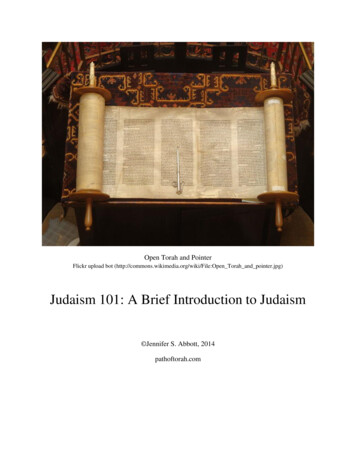
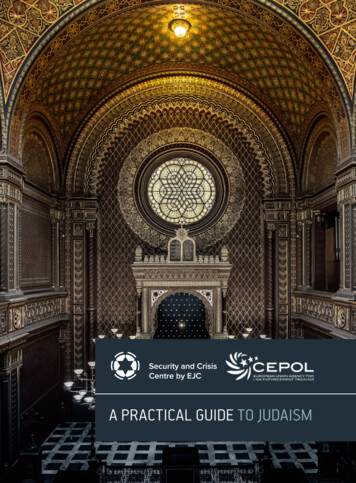

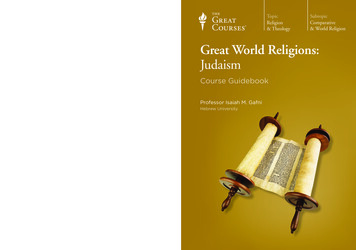

![[Goodman Martin] Judaism in the Roman World](/img/16/goodman-2007.jpg)


